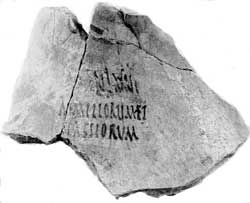
Click on the image for a larger version.
|
Image
details:
The painted inscription on the neck of an
olive oil amphora. The most visible part of the inscription
reads Aemiliorum et / Cassiorum, referring to the shipper
of the olive oil, the firm of the Aemilii and Cassii.
Image ownership:
© Vindolanda Trust |
Over 50 inscriptions have been found at Vindolanda, one of the
larger samples from the northern frontier, but only a fraction of
what must have once existed. See for example an altar
erected by a third century prefect or an altar
erected by an unknown dedicant to the god mogons.
Although the tablets are by far the most frequently occurring written
objects from Vindolanda, the range of written media is wide. The
most formal texts are public inscriptions, for example altars, tombstones
or dedication slabs recording by whom and in whose honour a building
was erected. Over 50 inscriptions have been found at Vindolanda,
one of the larger samples from the northern frontier, but only a
fraction of what must have once existed. Many everyday items (instrumentum
domesticum) bear stamps, brands or graffiti, usually related
to the production, distribution or ownership of the objects or the
commodities they carried. On pottery vessels and amphorae stamps
and ink labels may reveal the producers, shippers, contents and
weight or volume. Scratched graffiti too may sometimes indicate
contents and ownership. On wooden barrels and buckets are brands
and graffiti related to manufacture, ownership and transport. Inscriptions
and stamps on leather items record names of producers and of customers.
As well as images of the emperor, coins also bear legends with the
abbreviated imperial titles. Lead weights often bear an explicit
indication of their weights (not always very accurate) and bone
counters too bear names and numbers. Not all writing was directly
functional. Some graffiti for example record personal sentiments
or scrawled lines of poetry. From the fort at Binchester
for example two tiles have been found bearing graffiti from the
same line of poetry. The Roman fort was a 'text-rich' environment
in which even minor everyday transactions depended on at least a
basic literacy. The varied uses of writing were so deeply embedded
as perhaps to have become unremarkable, an exceptional situation
for the ancient world and especially the north-west provinces where
literacy levels were otherwise low.
|